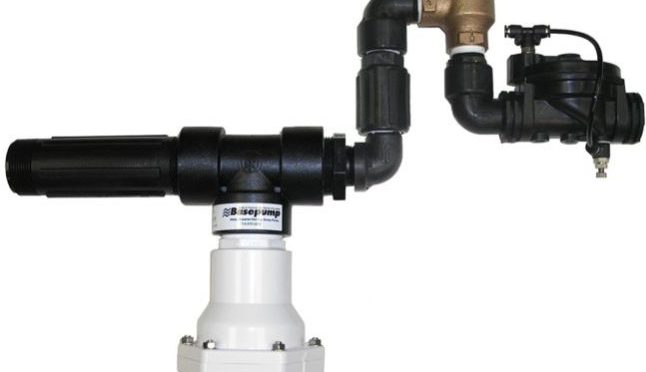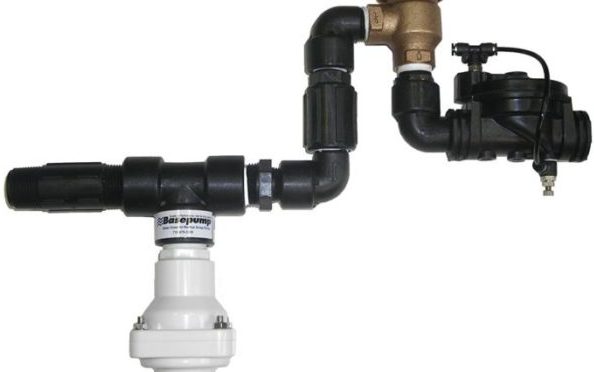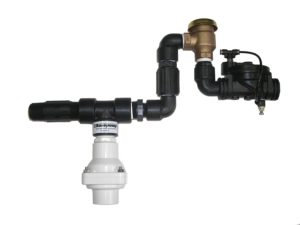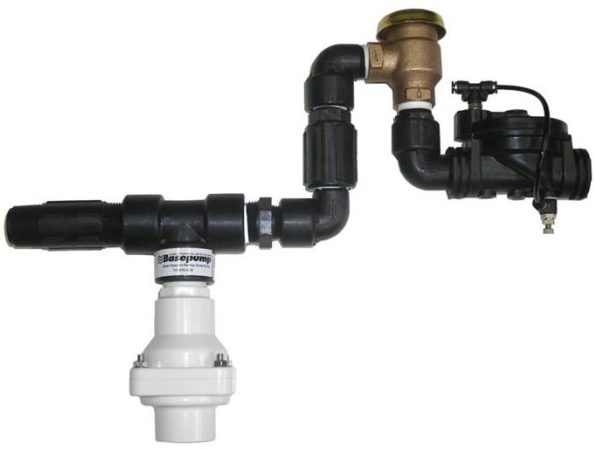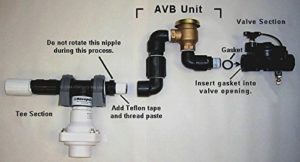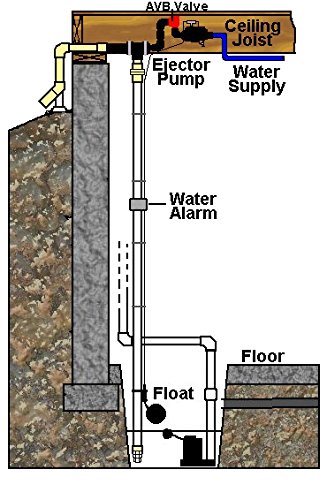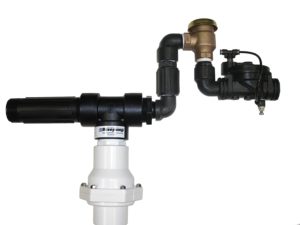 One of the most important parts of a dry basement is a good sump pump. We’ve reviewed dozens of them over the years, and have come to prefer certain models for certain tasks. The best AC pump? We think it’s the Zoeller M267. The top AC/DC combination model? The Wayne WSSM40V. The best backup that runs on batteries? You’re looking for the Wayne WSM3300. But what if you want a.) a water-based sump pump and b.) want a high level of back flow protection?
One of the most important parts of a dry basement is a good sump pump. We’ve reviewed dozens of them over the years, and have come to prefer certain models for certain tasks. The best AC pump? We think it’s the Zoeller M267. The top AC/DC combination model? The Wayne WSSM40V. The best backup that runs on batteries? You’re looking for the Wayne WSM3300. But what if you want a.) a water-based sump pump and b.) want a high level of back flow protection?
If you’re simply looking for the fastest water-powered sump, we give the award to the Basepump CB1500. However, if you need something that’s both fast and highly protected from back flow (whether in order to comply with municipal regulations or simply for water safety), you’ll want to look at the Basepump HB1000-AVB Water Powered Backup Sump Pump with Back Flow Prevention Vacuum Breaker. It’s basically a faster version of the RB 750-AVB; both include built-in atmospheric vacuum breakers to keep back flow of sump water out of your potable water line. Some municipalities require it (e.g., many in Indiana, Minnesota, Ohio, and Wisconsin), and even if it’s not required, it’s an additional layer of security you might wish to consider. Our full review is below, but if you’re wondering whether it’s a worthwhile investment, we think so, and you can buy it here.
Key Features of the Basepump HB1000-AVB (60 Second Summary)
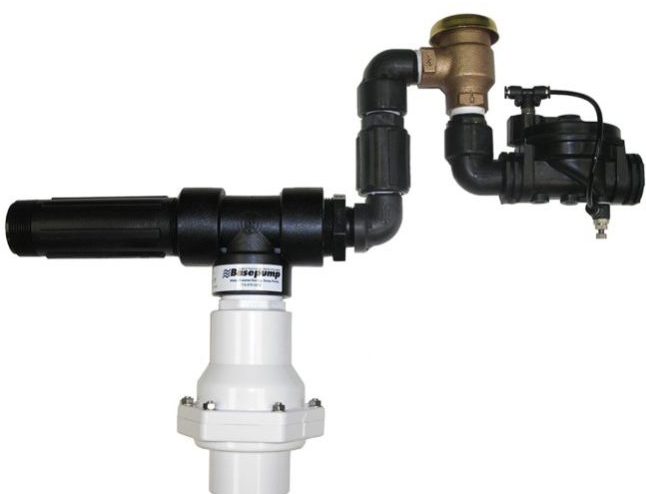 The Basepump HB1000-AVB is a water-powered backup sump pump that includes a built-in atmospheric vacuum breaker, or AVB, to prevent back flow of sump water into drinking water lines. As the pump is water based, it doesn’t require electricity, but does require water pressure from a city water system. It can remove up to 1,400 gallons of water per hour (1,400 GPH) and comes with a 5 year limited Basepump warranty. Weighing 10 pounds, it’s 16 inches long, 12 inches tall, and 8 inches wide.
The Basepump HB1000-AVB is a water-powered backup sump pump that includes a built-in atmospheric vacuum breaker, or AVB, to prevent back flow of sump water into drinking water lines. As the pump is water based, it doesn’t require electricity, but does require water pressure from a city water system. It can remove up to 1,400 gallons of water per hour (1,400 GPH) and comes with a 5 year limited Basepump warranty. Weighing 10 pounds, it’s 16 inches long, 12 inches tall, and 8 inches wide.
The HB1000-AVB features a 3/4 water intake that can be scaled up to 1 inch but not down to 1/2 inch, as this would not allow enough water pressure from a city line. The sump intake is 1 inch with a 1-1/2 inch discharge. Water pressure requirements range between 40 PSI and 90 PSI with two gallons of sump water removed for every city gallon pumped.
Pumping rates will vary depending on pumping height and water inlet pressure. At 40 PSI, the GPH is 950; this rises to 1,000 GPH at 60 PSI, 1,200 GPH at 80 PSI, and 1,400 PSI at 90 PSI. The max head is around 15 feet, although your limit will vary depending on water pressure and piping configurations.
As with the HB1000 and PRO variation, the HB1000-AVB features a 9 volt powered high water alarm that sounds at 85 dB.
How Does the Basepump HB1000-AVB Compare to the HB1000-PRO and HB1000?
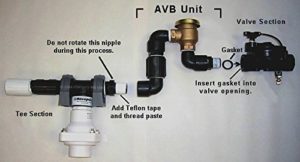 The primary difference between the HB1000-AVB, the HB1000-PRO, and the HB1000 is the presence of the atmospheric vacuum breaker, or AVB, with the HB1000-AVB. If you buy the HB1000-PRO, you get the advantage of having virtually everything you need for a complete installation included out of the box. However, you can of course buy the necessary accessories separately. But what exactly makes the AVB worth purchasing?
The primary difference between the HB1000-AVB, the HB1000-PRO, and the HB1000 is the presence of the atmospheric vacuum breaker, or AVB, with the HB1000-AVB. If you buy the HB1000-PRO, you get the advantage of having virtually everything you need for a complete installation included out of the box. However, you can of course buy the necessary accessories separately. But what exactly makes the AVB worth purchasing?
An AVB is a firewall for your drinking water. It keeps sump water from entering your drinking water line if back flow occurs during a pumping cycle. Without one, if pressure drops from your water line while it’s flushing water through the sump pump, it can create a vacuum that siphons sump water upstream and back into your municipal water line. The AVB valve acts to interrupt this by opening up, destroying the vacuum, and killing the siphon. Thanks to an AVB, contaminated sump water can’t enter the water your family drinks. Each Basepump water pump includes a check valve already that’s designed to prevent this, but this is an additional security check that both homeowners may appreciate and municipalities may require.
Our Short and Long Term Experiences Installing and Using the Basepump HB1000-AVB
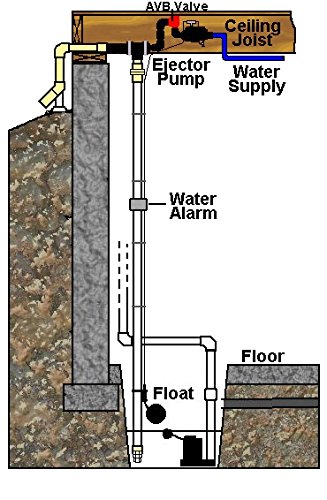 It doesn’t take more than around 3 to 4 hours to install the HB1000-AVB as long as you have some plumbing experience or know someone who does. If you need additional time, it will be due to the need to run an additional discharge line from the pump out of your home, since you can’t simply patch into the line for your primary sump pump. While this does add to the installation process, it does give you a fully redundant sump pump compared to the main system, which means you’re not going to find yourself with a flooded basement simply because your main line became clogged or damaged in the middle of a flash flood.
It doesn’t take more than around 3 to 4 hours to install the HB1000-AVB as long as you have some plumbing experience or know someone who does. If you need additional time, it will be due to the need to run an additional discharge line from the pump out of your home, since you can’t simply patch into the line for your primary sump pump. While this does add to the installation process, it does give you a fully redundant sump pump compared to the main system, which means you’re not going to find yourself with a flooded basement simply because your main line became clogged or damaged in the middle of a flash flood.
As with other water pumps, the key to longevity is to remember not to exceed the water pressure limit at the intake. Make sure your city isn’t delivering more than 90 PSI to your home and you’re more or less set with sump pump maintenance for the life of the pump.
Troubleshooting and Installation Tips to Get Your Basepump HB1000-AVB Working Sooner
Make sure you have enough water volume to drive the HB1000-AVB; Basepump recommends the bucket test. If you can fill up a 5 gallon bucket to within 2 inches of the brim (i.e., 5 gallons’ worth of water) from an outdoor spigot in under 30 seconds, you’ll have enough water flow to make the HB1000-AVB work in your basement. If it takes more than 30 seconds but under 40, you’ll want to pass on the HB1000-AVB and get the RB 750-AVB. If it takes longer than 40 seconds, neither is likely to work, and you’d be better off with a DC-based sump pump–of these, the Wayne WSM3300 is our favorite.
Basepump HB1000-AVB Pros, Cons, and Value Comparison
When installing the HB1000-AVB, make sure you install the AVB valve at least 6 inches higher than wherever you’re planning on discharging water. This safety is built into the pump, but if you don’t ensure that the water discharge is either level to the discharge outlet or sloping downward from it, water won’t drain out of the pump when the pump turns itself off. And if the water doesn’t drain out naturally, whatever water is left over after shut off will end up in your basement after flowing out of the open AVB valve, since the valve can and does open under pressure.
If back flow prevention is a priority, there isn’t a better option on the market right now than the HB1000-AVB in our books. It pumps a very good amount of water for a water-based sump pump, installs relatively quickly and without the need for unnecessarily complex routings, and it’s also available for a competitive price relative to the non-AVB versions of the HB1000. At this level, it’s hard to see how it could be improved except through making it faster or by including additional accessories to make it easier to install out of the box like the HB1000-PRO. Overall, we’re very satisfied and readily recommend it to anyone interested in no-nonsense back flow prevention and a greater pumping rate than that available in the RB 750-AVB.
You can buy the Basepump HB1000-AVB here on Amazon. You can buy the Basepump RB 750-AVB here.You can buy the Basepump HB1000-PRO here. You can buy the Basepump HB1000 here. You can buy the Wayne WSM3300 here on Amazon. You can buy additional PEX tubing here and SharkBite connectors here. You can buy a silent check valve here.
 If you find our work at PumpThatSump helpful, you can put our relentless reviewing of every pump and fixture on the market to the test by shopping via our links above for whatever you need to make your house a home. Despite being self-employed, we promise not to spend it all on health insurance.
If you find our work at PumpThatSump helpful, you can put our relentless reviewing of every pump and fixture on the market to the test by shopping via our links above for whatever you need to make your house a home. Despite being self-employed, we promise not to spend it all on health insurance.
